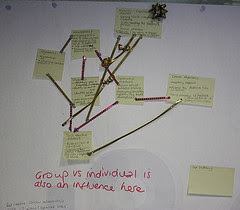 MUCH OF THE WORK I DO WITH BOARDS involves some level of assessment about organizational strengths and weaknesses and the structure of the board to address them. About three-quarters of these groups will eventually get around to voicing the fact that they don't do enough talking about these most basic, yet most critical, issues. In the hustle of organizational life, these boards and staff haven't yet realized that they can take some "time out" to review and reflect.
MUCH OF THE WORK I DO WITH BOARDS involves some level of assessment about organizational strengths and weaknesses and the structure of the board to address them. About three-quarters of these groups will eventually get around to voicing the fact that they don't do enough talking about these most basic, yet most critical, issues. In the hustle of organizational life, these boards and staff haven't yet realized that they can take some "time out" to review and reflect.Self-assessment can be many things: it can focus on organizational strengths and weaknesses, it can focus on board effectiveness in broad ways or it can focus solely on how the board is working at one meeting. Macro or micro, a bit of self-assessment is, as the old advertising slogan declared, "the pause that refreshes."
So, how might you go about some self-assessment with your board if you've never done anything like it before? I think one of the easiest ways to get the conversation started is simply to devote time at a board meeting to make a list on a flip chart of organizational strengths and weaknesses. It's highly likely that you'll uncover a great deal of consensus about some basic issues that you might not have known existed. That alone can be a tremendous sense of accomplishment for a group!
Once you've gone around the table and encouraged everyone to add an item or two to the list, take some time to figure out what 1-3 weaknesses deserve some attention right away. It's likely the discussion will result in some immediate actionable steps.
Or you might simply want to pose a question to get folks talking about why they care about the organization and want to be a part of it. This won't get you much critical analysis about organizational effectiveness, but it will encourage board members to open up in ways they generally wouldn't otherwise. This type of conversation helps to build a sense of trust and teamwork that can lead to critical analysis.
Want to go a bit more in-depth? I think a survey tool is a good way to encourage deeper reflection. You'll find a number of self-assessment tools online ranging from one-page, check-the-box surveys designed to gauge the level of understanding or engagement of board members in the big chunks of their responsibilities, to longer, more nuanced surveys. All are fair game for adaptation.
One survey I'm working with right now attempts to gauge a board member's understanding and alignment around the following areas: mission, finance, compliance, board composition and function, and board-director interface. My client and I adapted it from a survey used by a similar cultural institution. This survey ends with the request to "Please finish this sentence using your own words: Serving on this board board has helped me to develop...." Concerns raised in this survey will be used to develop a board-staff retreat agenda.


Comments